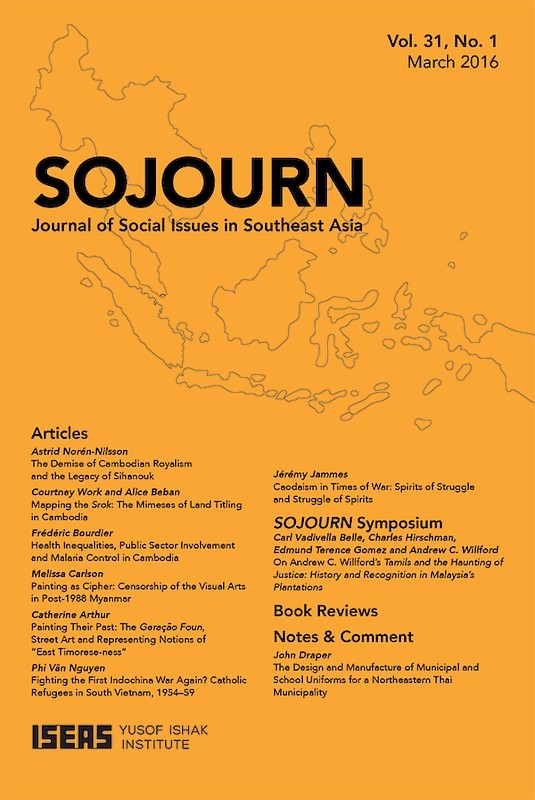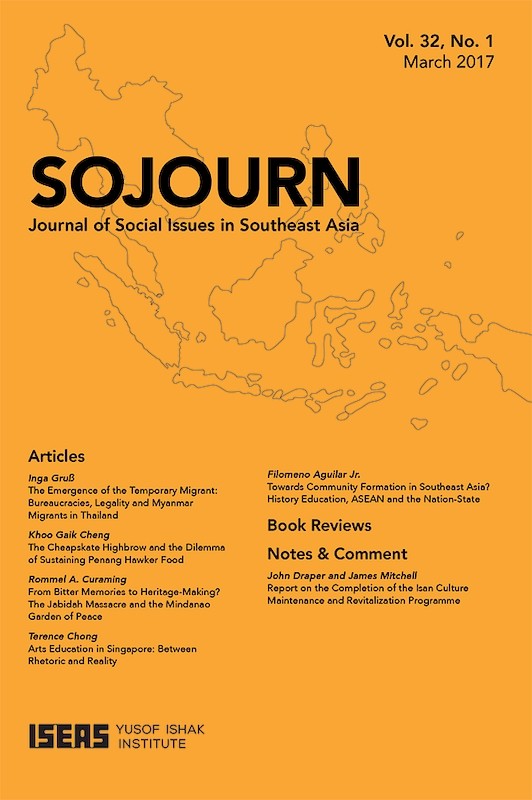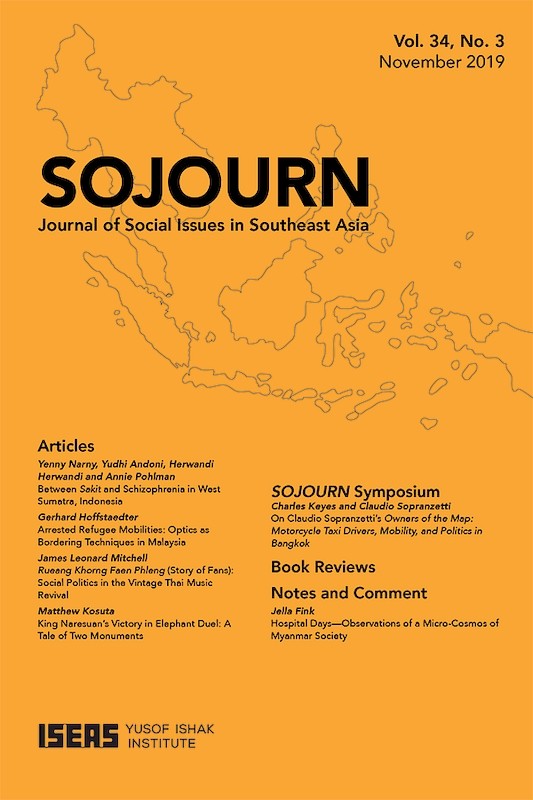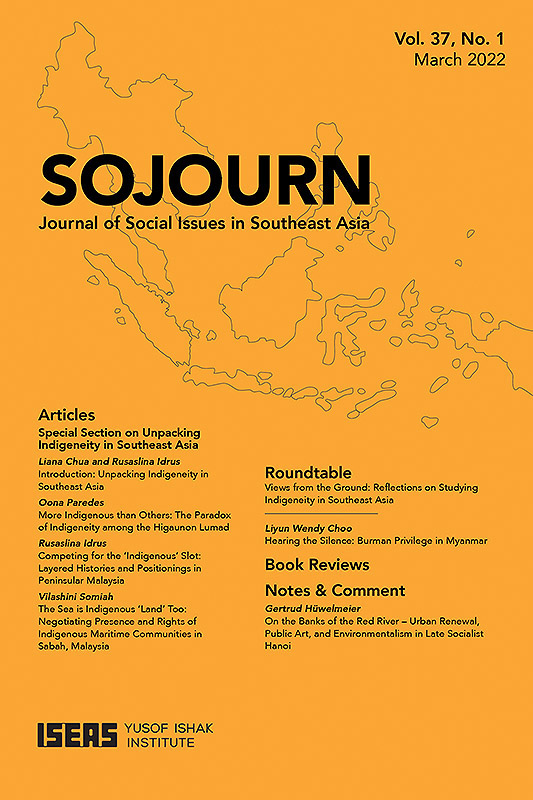SOJOURN: Journal of Social Issues in Southeast Asia Vol. 31/1 (March 2016)

Michael J Montesano, editor
Date of publication:
March 2016
Publisher:
ISEAS – Yusof Ishak Institute
Number of pages:
375
Code:
SJ31/1
Contents
-
SOJOURN: Journal of Social Issues in Southeast Asia Vol. 31/1 (March 2016)
[Whole Publication, ISSN: 17932858] -
Preliminary pages
- ARTICLES
-
The Demise of Cambodian Royalism and the Legacy of Sihanouk, by Astrid Norén-Nilsson, author see abstractCambodian royalism is in its death throes. While the death of King-Father Sihanouk in 2012 caused an outburst of popular emotion, in the national elections held the following year royalists failed for the first time to win any parliamentary seats. A detailed case study of the difficulty of transposing royal legitimacy to the party-political context explains this apparent paradox. During the Second Kingdom (1993–present) a largely hidden struggle to imbue royalism with meaning has unfolded. At the centre of this struggle has been the difficulty of transferring legitimacy from Sihanouk to other royalist actors, and in particular to his son Norodom Ranariddh. Sihanouk’s unmatchable significance has resulted in formidable challenges that now confront Cambodian royalism.
-
Mapping the Srok: The Mimeses of Land Titling in Cambodia, by Courtney Work, Alice Beban, authors see abstractIn June 2012, Cambodia's prime minister issued an order on land titling that deployed student volunteers to survey and map the country’s territory. Examination of this initiative at the theoretical intersections of mapping, mimicry and governmentality demonstrates the violent exclusions inherent in cadastral projects that restrict measuring and titling to only “productive” properties. In a field of speculation and local power the initiative dramatically refashioned the land to mimic in advance the expectations of the Map. The transformations altered land access and use in ways that told two stories about the power of the Map: “clear it or lose it” and “if you clear it, you can have it”. Neither story was fully realized, but the land was transformed nonetheless.
-
Health Inequalities, Public Sector Involvement and Malaria Control in Cambodia, by Frédéric Bourdier, author see abstractCambodia is constructing a broad partnership to guide the delivery of public health services in a context of historical anarchy in the health sector and of contemporary political obstacles. Ironically, the conditions of this partnership undermine the sovereignty of the national programme and hinder the ability of the government to provide comprehensive services. National authorities have given in to the pressure of international funding agencies to adopt approaches characterized by verticalization, multicentred interventions, volunteerism and private partnership. The malaria eradication programme is an example of how the disjointed strategy of combining various interventions can lead to increasing spatial and social health inequalities. In addition, the Cambodian government is often overburdened in trying to manage a multitude of frequently incoherent external interventions. The criteria for efficient delivery reveal an unsustainable national public health vision. Local planners should reconsider the parameters under which they engage with external parties and shore up the autonomy of their decision-making.
-
Painting as Cipher: Censorship of the Visual Arts in Post-1988 Myanmar, by Melissa Carlson, author see abstractThe censorship regime of the SLORC-SPDC era (1988–2011) shaped the development of Burmese art, not only imposing limitations on artists but also driving them to develop a new artistic vocabulary. This vocabulary is crucial to the understanding of contemporary Burmese visual art and to explaining the persistence of censorship in the post-2011 semi-civilian era. Instead of being silenced, Burmese artists learned to speak with a voice that was more subtle, but no less potent. Interviews conducted with Burmese painters, curators and a current member of the Censorship Board provide a first-hand perspective on how experimental artists and the state struggled to define national identity under the SPDC-SLORC regime.
-
Painting Their Past: The Geração Foun, Street Art and Representing Notions of East Timorese-ness, by Catherine Allerton, author see abstractOf the challenges confronting the nation-building project in Timor-Leste, the “generation gap” is one of the most important. The history of Timor-Leste, characterized by foreign occupations by both Portugal and Indonesia, has produced an emerging national identity founded on the concept of suffering in the name of national self-determination. Official state narratives that outline a national identity based on the recent struggle for independence have privileged the generation of East Timorese whose members led the resistance movement against the Indonesian occupation. This emphasis has not only overlooked youth involvement in the liberation struggle, but it has also estranged the younger generation of East Timorese from the nation-state. The examination of street art, the medium most accessible to members of Timor-Leste’s Geração Foun, or “new generation”, permits exploration of the ways that they identify with official notions of an emerging national identity.
-
Fighting the First Indochina War Again? Catholic Refugees in South Vietnam, 1954–59, by Phi Vân Nguyen, author see abstractVietnam War studies have often focused on the United States’ commitment to fight communism, but Catholic refugees who moved to the South after the 1954 Geneva Agreements were also determined to fight against Hanoi. In publications associated with these refugees, two fundamental factors explain their anti-communism: their desire to avenge their forced departure from the North and their opposition to atheism. An analysis of these refugees’ focus on uniting Vietnam and freeing it from communism sheds new light on the aftermath of their migration, on the political significance of religious faith and on the fashioning of a non-communist nationalism in Vietnam.
-
Caodaism in Times of War: Spirits of Struggle and Struggle of Spirits, by Jérémy Jammes, author see abstractCaodaism is an indigenous and syncretistic religion of Vietnam that appeared in the 1920s, during the French colonial period. Caodaists believe that they have the responsibility to save humanity through spirit-mediumship and conversion before the impending end of the world. Their theology thus clearly intersects with politics: Cao Đài texts encouraged Vietnamese nationalism and endorsed the overthrow of French colonial rule. Between 1940 and 1965, Caodaist leaders made a range of strategic choices during wartime: armed struggle, collaboration, alliance and, finally, diplomacy. The biographies of three important Caodaist leaders highlight the diversity of their alliances, disagreements and struggles, while making clear that all three shared the ultimate and unifying purpose of transforming Caodaism into the “national religion” of Vietnam.
- SOJOURN SYMPOSIUM
-
Tamils and the Haunting of Justice: History and Recognition in Malaysia's Plantations. By Andrew C. Willford. Review essays by Carl Vadivella Belle, Charles Hirschman and Edmund Terence Gomez, with a response from Andrew C. Willford, by Carl Vadivella Belle, Charles Hirschman, Edmund Terence Gomez, Andrew C Willford, authors
- BOOK REVIEWS
-
BOOK REVIEW: A History of Early Modern Southeast Asia, 1400–1830 by Barbara Watson Andaya and Leonard Y. Andaya, by Nicholas Tarling, author
-
BOOK REVIEW: Tuked Rini, Cosmic Traveller: Life and Legend in the Heart of Borneo by Monica Janowski, by Jon Henrik Ziegler Remme, author
-
BOOK REVIEW: Identity and Pleasure: The Politics of Indonesian Screen Culture by Ariel Heryanto, by James B Hoesterey, author
-
BOOK REVIEW: Les Oracles du Cao Ðài: Étude d’un mouvement religieux vietnamien et de ses réseaux [The oracles of Cao Đài: A study of a Vietnamese religious movement and its networks] by Jérémy Jammes, by Gareth Hoskins, author
-
BOOK REVIEW: Essential Trade: Vietnamese Women in a Changing Marketplace by Ann Marie Leshkowich, by Jayne S Werner, author
-
BOOK REVIEW: The Lost Territories: Thailand's History of National Humiliation by Shane Strate, by Barend Jan Terwiel , author
-
BOOK REVIEW: A Sarong for Clio: Essays on the Intellectual and Cultural History of Thailand, Inspired by Craig J. Reynolds edited by Maurizio Peleggi, by Michael J Montesano, author
-
BOOK REVIEW: Brunei: From the Age of Commerce to the 21st Century by Marie-Sybille de Vienne, by Justin McDaniel, author
-
BOOK REVIEW: Narrative Structures in Burmese Folk Tales by Soe Marlar Lwin, by Gerry Abbott, author
- NOTES AND COMMENT
-
The Design and Manufacture of Municipal and School Uniforms for a Northeastern Thai Municipality, by John Draper, author see abstractThe Isan Culture Maintenance and Revitalization Programme is a four-year, 500,000-euro programme devised and implemented by four municipalities and the College of Local Administration of Khon Kaen University in Northeast Thailand. The design and manufacture — using traditional processes adapted for making Western-style shirts that first became popular in Thailand in the first decade of the twentieth century — of student uniforms for Ban Phai municipality is one of the action lines of the Isan Culture Maintenance and Revitalization Programme. A brief review of Thailand’s decentralization process is followed by a section on school uniforms. The project in Ban Phai had four phases: a survey of citizens’ attitudes towards the use of traditionally designed and woven clothing; a capacity survey to review the local market; design and manufacture of municipal uniforms; and design and manufacture of school uniforms. The result was the production of more than 400 hybrid jackets for municipal officers with local, national and international characteristics and more than 1,200 similarly hybrid student shirts, using both traditional and machined processes and materials.






